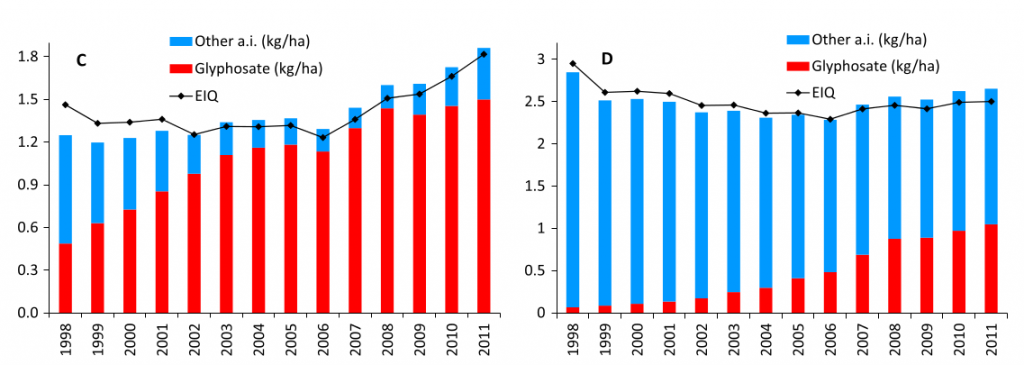But, once again, we are left to wonder whether that’s good or bad.
A new paper was just published in the journal Science Advances that analyzes pesticide use data for farmers in the U.S. between 1998 and 2011. The authors (Edward Perry et al.) are currently agricultural economists at four different universities (Kansas State, Virginia, Michigan State, and Iowa State). Their goal was to determine if pesticide use differed between farmers using GMO varieties and farmers who did not use GMO varieties. Overall, they concluded that farmers planting GMO soybeans used 28% more herbicide than non-GMO users, and GMO corn users applied 1.2% less herbicide than non-GMO users. However the authors didn’t tease out how much of that increase was simply due to differences in use rates between glyphosate and other herbicides, making the conclusion of only marginal value (more on that below).
The major strength of the paper is their approach to comparing GMO-adopters to non-adopters, as their data set explicitly allowed this comparison. Many previous efforts to make this comparison have relied on calculations and assumptions that have been disputed by various critics on either side of the GMO debate. The analysis in this new paper doesn’t make any of these assumptions, and instead simply analyzes the empirical data. There are certainly shortcomings in this approach, but it is nice to see a no-assumptions version of the data used for this purpose. However, they used a proprietary data source, so we can’t inspect the data any further to see which non-glyphosate herbicides might be contributing to the observed trends.
Unfortunately, the authors based their analysis on two very flawed metrics if we want to infer anything regarding the impact of pesticide use changes. Perry et al. quantified the total weight of combined pesticides, and EIQ weighted pesticide use.
The recent report from the National Academy of Sciences explicitly discourages comparing the total weight of multiple pesticides used in GMO vs non-GMO crops, since the total weight applied gives little information about toxicity, exposure, or risk, which can differ greatly between active ingredients. The NAS report states (emphasis mine):
“Assessing the relative effects of diverse herbicides can be challenging, but it is clear that simply determining if the total kilograms/hectare of herbicide used per year has gone up or down is not useful for assessing human or environmental risks.”
“Researchers should be discouraged from publishing data that simply compares total kilograms of herbicide used per hectare per year because such data can mislead readers.”
Perry et al. acknowledge this deficiency in their article, stating:
“A concern with this (common) procedure is that the total weight associated with a bundle of heterogeneous chemicals is a poor measure of environmental impact.”
But then they did it anyway.
To correct for this deficiency, though, the authors decided to compare the Environmental Impact Quotient (EIQ) of the pesticides. They briefly acknowledge (like really, really briefly, using only 3 words) that the EIQ is imperfect (by citing my work on this subject, as reference #24 is a paper we wrote on the EIQ):
“Despite certain shortcomings (24), the EIQ’s appeal in our context is that it converts an array of attributes specific to each pesticide into a single value meant to summarize the toxicity of the chemical.”
But then they did it anyway. Those “certain shortcomings” shouldn’t be dismissed so easily, if one really wants to determine the environmental impact of pesticide use related to GMO crops. The NAS report seemed to agree with this:
“Kniss and Coburn (2015) argued convincingly that neither kilograms per hectare nor EIC [sic] is a useful metric and that only careful case-by-case evaluation of the environmental and health impacts of each herbicide will yield useful assessments and recommend use of the EPA risk-quotient approach.”
Perry et al. use the EIQ anyway, because it is simple. But the simplicity of the EIQ is exactly what makes it a very poor indicator of risk. It is disappointing that they were aware of the severe deficiencies of the EIQ, yet still decided to use it. The EIQ is especially poor for evaluating herbicides. We showed in our PLOS ONE article on the EIQ that over 25% of the herbicide EIQ can be explained by one component of the EIQ formula that has no quantitative data in support (application timing) and is not actually an attribute of the herbicide to begin with. [UPDATE: I’ve also recently shown that the EIQ is about as good at estimating environmental impact as a random number generator.]
Figure 1 in the new Perry et al. paper shows a striking confirmation of one of our other findings, that the EIQ does not improve risk assessment compared to total amount applied. In our PLOS ONE paper, we argued:
“Because of the strong correlation between Field EIQ and herbicide use rate, the Field EIQ should be considered, at best, a minimal improvement compared to simply estimating the weight of herbicide applied per unit area.”
The EIQ-weighed herbicide data in Perry et al.’s Figure 1 follow the weight applied data almost exactly, confirming the correlation. Other authors have made similar vigorous criticism of the EIQ over the years, and it is, frankly, disappointing to see continued use of the EIQ in the peer-reviewed literature. For more information (and links to other criticisms) you can read a post about the EIQ here.

Perry et al. conclude that the pattern of changes in herbicide use is consistent with the emergence of glyphosate resistance in weeds. This is certainly plausible, but it is very difficult to conclude a causal relationship. In fact, my recent analysis of USDA data shows an increase in the number of herbicides being used in wheat and rice also, which have no glyphosate-resistant varieties. It is possible that the increase in herbicide use relates to an increase in herbicide resistant weeds in general, but I don’t think glyphosate-resistance alone can explain it. If the increases in the amount or number of herbicides used is due to glyphosate resistant weeds, why are we seeing similar increases in crops where there are no glyphosate-resistant varieties?
So although I appreciate the new methodology used in this analysis, I don’t think it provides much new information (the analysis stops at 2011) and the information it does provide isn’t all that useful. I don’t think the trends and the differences they show will be very useful from either a practical or policy perspective.
Perry ED, Ciliberto F, Hennessy DA, Moschini G. (2016) Genetically engineered crops and pesticide use in U.S. maize and soybeans. Science Advances. 2016;2:e1600850. DOI: 10.1126/sciadv.1600850

